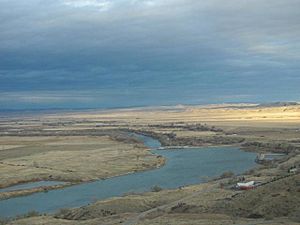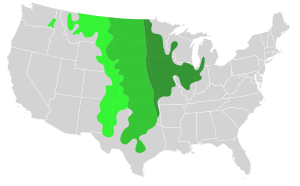Mixed grass prairie facts for kids


A mixed-grass prairie is a unique type of grassland. It's like a middle ground, or an ecotone, found between the very tall tallgrass prairies and the shorter shortgrass prairies. This kind of prairie has more different kinds of plants and animals than either the tallgrass or shortgrass prairies alone. You can find mixed-grass prairies in the central part of the Great Plains. They stretch from central Texas in the United States all the way up into southeastern Manitoba, Alberta, and Saskatchewan in Canada.
Contents
What is a Mixed-Grass Prairie?
A mixed-grass prairie is a large area of land mostly covered by grasses. It gets its name because it has a mix of both tall and short grasses. This mix creates a rich environment for many different living things.
The "Ecotone" Explained
An ecotone is a special zone where two different ecosystems meet and blend. Think of it like the edge of a forest where it meets a field. In the case of the mixed-grass prairie, it's where the wet, tallgrass areas meet the dry, shortgrass areas. This blending makes it a very diverse place. It has plants and animals from both types of prairies, plus some unique ones.
Why is it "Mixed"?
The types of grasses that grow in a prairie depend a lot on the amount of rainfall. Tallgrass prairies get more rain, so their grasses grow very high. Shortgrass prairies get less rain, so their grasses are shorter. The mixed-grass prairie gets a medium amount of rain. This allows both taller grasses and shorter grasses to thrive side-by-side. This mix helps the prairie stay healthy and strong.
Where Can You Find Mixed-Grass Prairies?
Mixed-grass prairies are a big part of the Great Plains in North America. This huge area stretches across the middle of the continent.
Location in the United States
In the United States, these prairies cover parts of several states. You can find them in states like North Dakota, South Dakota, Nebraska, Kansas, Oklahoma, Montana, Wyoming, Colorado, and Texas. They form a wide band through the heart of the country.
Location in Canada
North of the border, mixed-grass prairies continue into Canada. They are found in the southern parts of the provinces of Manitoba, Saskatchewan, and Alberta. These areas are often called the "Canadian Prairies."
Plants of the Prairie
The plants in a mixed-grass prairie are very special. They are adapted to survive dry periods and cold winters.
Types of Grasses
You will see many kinds of grasses here. Some common tall grasses include big bluestem and switchgrass. Shorter grasses like buffalo grass and blue grama also grow well. This mix of tall and short grasses creates different habitats for animals. It also helps the soil stay healthy.
Other Prairie Plants
Besides grasses, many beautiful wildflowers grow in the mixed-grass prairie. These include coneflowers, sunflowers, and milkweed. These flowers add color to the landscape. They also provide food for insects and other animals.
Animals of the Prairie
Mixed-grass prairies are home to a wide variety of animals. Many of these animals are specially adapted to live in open grasslands.
Mammals of the Prairie
Large mammals like bison once roamed these prairies in huge herds. Today, you might see pronghorn, deer, and coyotes. Smaller mammals like prairie dogs, badgers, and ground squirrels are also common. Prairie dogs are especially important because their burrows provide homes for many other animals.
Birds and Insects
Many bird species live in the mixed-grass prairie. These include prairie chickens, meadowlarks, and various kinds of hawks. Insects like grasshoppers, butterflies, and bees are also abundant. They play a vital role in pollinating plants and serving as food for other animals.
Why Are Prairies Important?
Mixed-grass prairies are very important ecosystems. They provide many benefits to the environment and to people.
Biodiversity Hotspot
As an ecotone, the mixed-grass prairie is a "biodiversity hotspot." This means it has a very high number of different species of plants and animals. Protecting these areas helps to keep many species from becoming endangered.
Natural Benefits
Prairies help keep our planet healthy. Their deep root systems prevent soil erosion, especially during strong winds. They also help water soak into the ground, which recharges underground water supplies. Prairies also store carbon in their soil, which helps to reduce greenhouse gases in the atmosphere.
Conservation Efforts
Sadly, much of the original mixed-grass prairie has been lost. It has been turned into farmland or developed for cities. Because of this, many groups are working to protect and restore these valuable grasslands. These efforts help ensure that future generations can also enjoy the beauty and benefits of the mixed-grass prairie.

